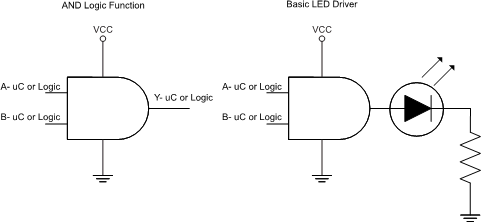SCES198N April 1999 – December 2015 SN74LVC2G08
PRODUCTION DATA.
- 1Features
- 2Applications
- 3Specifications
- 4Detailed Description
- 5Application and Implementation
- 6Power Supply Recommendations
- 7Layout
- 8Device and Documentation Support
- 9Mechanical, Packaging, and Orderable Information
封装选项
机械数据 (封装 | 引脚)
散热焊盘机械数据 (封装 | 引脚)
订购信息
5 Application and Implementation
NOTE
Information in the following applications sections is not part of the TI component specification, and TI does not warrant its accuracy or completeness. TI’s customers are responsible for determining suitability of components for their purposes. Customers should validate and test their design implementation to confirm system functionality.
5.1 Application Information
The SN74LVC2G08 is a high-drive CMOS device that can be used for implementing AND logic with a high output drive, such as an LED application. It can produce 24 mA of drive current at 3.3 V, making it Ideal for driving multiple outputs and good for high-speed applications up to 100 MHz. The inputs are 5.5-V tolerant allowing it to translate down to VCC.
5.2 Typical Application
 Figure 4. Typical Application
Figure 4. Typical Application
5.2.1 Design Requirements
This device uses CMOS technology and has balanced output drive. Tak care to avoid bus contention because it can drive currents that would exceed maximum limits. The high drive will also create fast edges into light loads so routing and load conditions must be considered to prevent ringing.
5.2.2 Detailed Design Procedure
- Recommended Input Conditions
- Rise time and fall time specs. See (Δt/ΔV) in the Recommended Operating Conditions table.
- Specified high and low levels. See (VIH and VIL) in the Recommended Operating Conditions table.
- Inputs are overvoltage tolerant allowing them to go as high as (VI maximum) in the Recommended Operating Conditions table at any valid VCC.
- Recommended Output Conditions
- Load currents must not exceed (IO maximum) per output and must not exceed total current (continuous current through VCC or GND) for the part. These limits are located in the Recommended Operating Conditions table.
- Outputs must not be pulled above VCC in normal operating conditions.
5.2.3 Application Curves
 Figure 5. ICC vs Frequency
Figure 5. ICC vs Frequency